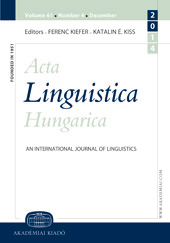Where are possible worlds? (arguments for ReALIS)
Where are possible worlds? (arguments for ReALIS)
Author(s): Gábor Alberti, Judit KleiberSubject(s): Semantics
Published by: Akadémiai Kiadó
Keywords: (eliminative) possible-worlds semantics; dynamic semantics; intensionality;
Summary/Abstract: We follow Pollard (2007) in assuming that the mainstream Kripke/Montagueinspired possible-worlds semantics is “a framework known to have dubious foundations” (primarily because of the granularity problem), and “worlds are constructed from propositions […], and not the other way around”. We intend to work out this approach in a DRT-based framework, called ReALIS, in order to account for phenomena concerning referent accessibility, at the same time. We claim that our system offers a general solution to problems of intensional identity, and it is devoid of DRT’s “extra level” problem—by embedding discourse representations in the world model, not directly but as parts of the representations of interpreters’ minds, i.e., their (permanently changing) information states/“internal worlds”. Hence, there is simply no intensionality in ReALIS as interpreters’ “worldlets” (in description of their brains within the entire model of the universe) carry all kinds of information (BDI, guesswork, dream) typically “entrusted to” possible worlds.
Journal: Acta Linguistica Hungarica (Since 2017 Acta Linguistica Academica)
- Issue Year: 59/2012
- Issue No: 1-2
- Page Range: 3-26
- Page Count: 24
- Language: English

